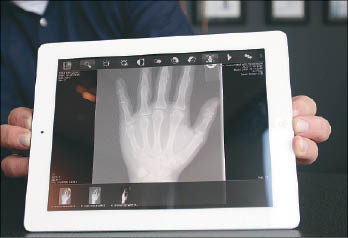
Home » Calling up medical images ... there's an app for that, too
Calling up medical images ... there's an app for that, too
Inland Imaging is testing system that lets docs view results on mobile devices

February 16, 2012
In 2007, Spokane neurological surgeon Dr. Dean Martz approached Jon Copeland, CEO of Inland Imaging Business Associates LLC, and asked if Inland Imaging could find a way to send MRIs and other medical images to his iPhone.
Copeland's response: You're crazy.
Fast forward four years, and Inland Imaging is one of two international beta-test sites for an application that enables physicians to retrieve and read images on an iPhone, Droid phone, iPad, or other type of mobile device.
Called eUnity and developed by a Waterloo, Ont.-based company called Client Outlook Inc., the technology is used widely on desktop computers, but only now is being tested on mobile devices.
"The whole mobile concept for physicians is extremely important," Copeland says. "Most physicians are on the move."
In addition to Martz, who is a principal at Inland Neurosurgery & Spine Associates PS and the past president of the Washington State Medical Association, other physicians currently using eUnity are Dr. A.J. Martinez, a radiologist at Kootenai Imaging, and Dr. Salil Manek, a neurologist at Rockwood Clinic PS.
Copeland says the beta test likely will continue through the first quarter of the year, with 20 to 30 physicians to be added to the testing. He says Client Outlook is scheduled to complete its testing in the next few months and to make eUnity available on a broad scale later this year.
The images are of a resolution comparable with those that physicians currently see when looking at images remotely on a desktop computer, Copeland says.
Through Inland Imaging's current system—known in the medical imaging industry as a Picture Archive Communications System—physicians can retrieve and view images on desktop computers. In physicians' offices and homes throughout the Inland Northwest, about 6,000 desktop computers are set up to view those images.
The eUnity technology, Copeland says, works in concert with that archiving system, which houses millions of images taken throughout the Inland Northwest since Inland Imaging began moving from film images to digital images 12 years ago. He says that each year, 1 million examinations from 40 health care centers throughout the region are added to the system.
Those images include those from mammograms, computed tomography scans, ultrasounds, and other types of medical images.
With the volume of information in that system, the archiving system is considered a health-information exchange, a broad term that refers to the electronic centralization of health data.
Martz says that since he became part of the beta test last month, he has been using the eUnity several times a week. In many cases, it allows him to review images and respond quickly when out of the office, whether he's at home or not.
"If I'm not sitting in my office where I have access, it gives me that flexibility," Martz says.
Conversely, he's been using the technology frequently in examination rooms with patients. For example, if he's with a patient who has had surgery to remove a tumor, he will show on his iPad a magnetic-resonance imaging scan that displays where the tumor had been and that it's no longer there.
"The nicest thing about it is that it's fast," Martz says. "You lift the cover, and it's there. If you're in an exam room and want to show a patient their film, it's there. It's nice for that."
Physicians download onto their mobile devices an application to access eUnity. Of course, a physician must be set up to use the system, and entry is password protected. Otherwise, the app functions just like any other one would download to a mobile device.
Martz says the image resolution on an iPad or other tablet is comparable to that on a typical desktop monitor, but an iPad has the added ability to magnify an image.
"Your ability to look at the image (on a tablet) is a little better than what you have," he says. "It's hard to imagine it won't become more and more popular as time goes on."
For Inland Imaging, one advantage is the eUnity system doesn't add to its data-storage requirement, a plus for a company that adds a terabyte a week of data storage, Copeland says.
"A zero footprint like that is a big thing, too," he says.
By and large, though, Copeland says Inland Imaging is trying to give physicians more options in receiving and reading images.
"What we're trying to do is add value," he says. "This is a whole new value add."
Latest News
Related Articles




